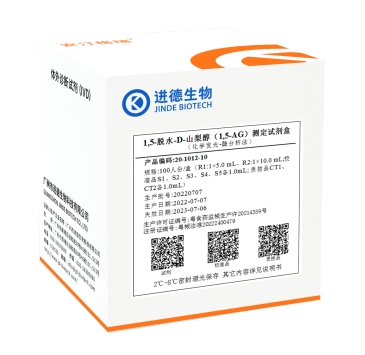1,5-AG(1,5-脫水-D-山梨醇)
1,5-Anhydroglucitol Chemiluminescent Enzymatic Assay

?? Description
1,5-Anhydroglucitol (1,5-AG), a glucose-like sugar found in most foods. 1,5-AG is an adjunctive test that is supported by over 500 studies just for its use in glycemic control, and is the ONLY marker specific to recent hyperglycemia and hyperglycemic excursions.1,5-Anhydroglucitol, also known as 1,5-AG, is a naturally occurring monosaccharide found in nearly all foods. Blood concentrations of 1,5-anhydroglucitol decrease during times of hyperglycemia above 180 mg/dL, and return to normal levels after approximately 2 weeks in the absence of hyperglycemia. As a result, it can be used for people with either type-1 or type-2 diabetes mellitus to identify glycemic variability or a history of high blood glucose even if current glycemic measurements such as hemoglobin A1c (HbA1c) and blood glucose monitoring have near normal values.
?? How Does it Work?
When blood glucose is well-controlled, glucose and 1,5-AG circulate in the bloodstream. The molecules are filtered by the kidneys and reabsorbed by the body. Urinary 1,5-AG is equal to the ingested 1,5-AG.
When glucose exceeds the renal threshold (>180 mg/dL*), glycosuria blocks reabsorption of 1,5-AG. 1,5-AG is excreted in the urine resulting in lower 1,5-AG levels.
The 1,5-AG test measures 1,5-AG from a serum or EDTA plasma blood sample.
Glycemic excursions (temporary increases in blood glucose) are associated with health complications. Standard tests for diabetes (e.g. random blood sugar and HbA1c) do not test for these excursions despite their association with several health complications. 1,5-anhydroglucitol (1,5-AG) is a validated indicator of glucose excursions in addition to short-term (1-2 weeks) hyperglycemia.
Detailed Description:
Diabetes treatment programs focus on controlling hyperglycemia (random glucose > 200 mg/dL) without causing hypoglycemia (glucose < 70 mg/dL). Glucose control is determined in a number of ways in current clinical practice. Immediate and fasting blood sugars are determined in routine chemistry tests. The standard measure of long-term diabetes control, HbA1c testing, provides a reliable reading of average blood glucose levels over a 2-3-month period. In patients with high HbA1c levels, HbA1c measurement guides management decisions and helps the clinician bring the long-term glucose levels under control in poorly controlled diabetic patients. Random blood sugars and HbA1c is limited in that they do not reflect glycemic control in intervals greater than the past few hours and 2-3 months. In particular, they do not provide an indication of frequent, temporary increases in blood glucose, termed glycemic excursions, which have been independently associated with several health complications. Since it takes months for HbA1c levels to stabilize, HbA1c levels are also not helpful for patients starting medication or changing drug therapy.
1,5-anhydroglucitol (1,5-AG) is a molecule found in the blood and is a validated indicator of glucose excursions and short-term (1-2 weeks) hyperglycemia. In healthy patients without diabetes, or those with well-controlled diabetes, 1,5-AG is maintained at a steady state in the blood. However, during glycemic excursions, the molecule is actively purged from the body through the urine. Cleared by the FDA in 2003, the GlycoMark assay measures 1,5-AG levels in the blood. Low levels of 1,5-AG indicate the presence of potentially harmful glycemic excursion over the last 1 to 2 weeks, which may have been missed during random blood glucose testing and not sensitively detected by HbA1c.
?? The 1,5-AG Test:
A blood test specific to detecting recent hyperglycemia and hyperglycemic excursions (occurring in the fasting state, postprandial, or both).
Reveals recent trends toward or away from HbA1c goals, suggesting improving or worsening control.
Is Independently associated with increased rates of diabetes complications.
When used with Glucose, Glycated albumin (GA),HbA1c, provides a more complete assessment of glycemic control to identify patients that may benefit from closer diabetes management.
Contact Us
Follow us
 Wechat
Wechat

